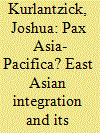|
|
|
Sort Order |
|
|
|
Items / Page
|
|
|
|
|
|
|
| Srl | Item |
| 1 |
ID:
076849


|
|
|
|
|
| Publication |
2007.
|
| Summary/Abstract |
Most days, the street outside the Thai embassy in Phnom Penh fills early with pedicab drivers shuttling old women to market. One winter day in 2003, however, a far different crowd gathered outside the Thai mission. Cambodian newspapers had misquoted a Thai television pop star as calling Cambodians "worms" and questioning whether Angkor Wat, Cambodia's ancient temple complex, should be returned to Thailand. Stoked by the report, mobs attacked Thai-owned businesses across Phnom Penh, causing millions of dollars worth of damage.
A decade ago, a conflict between two East Asian nations would have been resolved by the region's only major power, the United States, which had dominated trade, diplomacy, and culture in East Asia since World War II. In this case, Cambodia and Thailand sought out China to serve as an informal mediator. After the Chinese ambassador in Cambodia and Thailand to resolve their dispute, Chinese vice foreign minister Wang Yi helped the Thai and Cambodian representatives lay out their grievances. Chastened, the two sides began to resolve their dispute.
The Cambodian-Thai case is hardly unique. Over the past decade and particularly since the Asian financial crisis of the late 1990s, East Asia has begun to integrate, forming the beginnings of a true regional community and looking to actors within the region such as China, rather than the United States, to resolve security and economic disputes. Across East Asia, governments and leaders are developing their own institutions and intraregional trade patterns. They even have begun holding their first truly regional meeting, the annual East Asia Summit (EAS), which first convened in December 2005. Outside government, average people have developed a growing pan-Asian consciousness, the result of closer commercial links, the rise of an East Asian middle class, and the penetration of Asian pop culture products into households. In subtle ways, people across East Asia, like Europeans after World War II, are beginning to think of themselves as citizens of a region.
In recent years, as East Asia has been building regional ties and nascent institutions, the United States often has been absent from the region. By undervaluing East Asian integration, Washington has created the impression that it views East Asian regionalism as a threat to U.S. power. Yet, Asia's new identity and institutions need not be a challenge to the United States, and Washington must remain engaged with the region, which is now the engine of global economic growth and potentially the world's most dangerous security environment. If the United States can revamp its East Asia policy to capitalize on the benefits of pan-Asian institutions, it can remain vital in an era of Pax Asia-Pacifica.
|
|
|
|
|
|
|
|
|
|
|
|
|
|
|
|
|
|
|
|
|